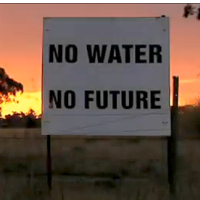Mendocino County Beats State to Declaration of Drought Emergency

While Governor Jerry Brown ponders declaring a statewide emergency drought disaster, Mendocino County declared one of its own Tuesday, clearing the way for the introduction of mandatory water-saving measures and assistance from the state.
Wells are reportedly drying up and Lake Mendocino, its key source of water, is near an all-time low level. The North Coast set a record for dryness in 2013, with just 7.67 inches of rain in the upper reaches of the Russian River. The Ukiah Daily Journal reported that Willits City Manager Adrienne Moore told the Board of Supervisors before it declared the emergency that her city estimated it had 100 days of water supply.
The county’s static water supply has been a heated subject of conversation at least since the last great drought in 1976-77 wreaked havoc. There is no agreement on how to even begin broadening the county’s water options to shield it from wild fluctuations in rainfall.
Lurking beneath discussions about how to cope with today’s short-term water shortage while planning for the future is the fear that the future is now. Mendocino County Supervisor Dan Hamburg said, “Nobody’s mentioned the elephant in the room, which is climate change. I’m afraid the new normal is low rainfall.”
Unless Mother Nature does a quick 180 and holds the pose for awhile, stories of deprivation in California, plentiful as they are right now, are almost certain to multiply. Stories already abound, like drought-squeezed cow-calf operations in Red Bluff, reservoirs well under 50% capacity and near-record low flows in the American River. The river’s flow has been reduced to save water behind the Folsom Dam, preserving the main drinking source for 500,000 people in the Sacramento area.
The Folsom Lake water level got so low that remnants of the Gold Rush-era mining town called Mormon Island, which was flooded in 1955 in anticipation of the dam, popped into view. It hadn’t been seen since, not even in the last, worst drought ever in 1976-77.
Wine broker Ciatti Co. told Reuters that 15,000 to 20,000 acres of grape vines in the state will be replaced with almonds and other crops that need less water. The state is coming off two big harvests in a row, but ripping out these vines would reduce vineyard acreage up to 3.7% from 546,000.
Reuters said a Ciatti email predicted, “The coming year in California will be characterized by drought and sustainability. The state is seeing a mass pullout of all low-bearing crops. Farmers have been forced to shift from crop diversification to salvaging crops that will provide them the most long-term sustainability.”
California is the world’s fifth largest supplier of food and other agricultural commodities. Agriculture is a $36.6 billion industry and generates another $100 billion worth of related economic activity in a state with a gross state product of $1.9 trillion. California’s economy is the 12th largest in the world.
Snowpack in the Sierras, which California relies on for a third of its water, is 20% of historic averages. Another major source of state water, the Colorado River has suffered through 14 years of drought. That hasn’t happened in more than a 1,000 years, but according to “a brace of global-warming studies” (pdf) referenced by the New York Times, predictions are that by 2050 rising temperatures alone could reduce Colorado flow up to 35%—and that is with no decline in rain factored in.
–Ken Broder
To Learn More:
Mendocino County Declares Drought Emergency (by Glenda Anderson, Santa Rosa Press Democrat)
Drought Emergency Declared for Mendocino County (by Tiffany Revelle, Ukiah Daily Journal)
California Grape Area Being Ripped up for Almonds (by Rudy Ruitenberg, Bloomberg News)
Drought Prompts Deep Cuts in American River Flows (by Matt Weiser, Sacramento Bee)
Colorado River Drought Forces a Painful Reckoning for States (by Michael Wines, New York Times)
- Top Stories
- Controversies
- Where is the Money Going?
- California and the Nation
- Appointments and Resignations
- Unusual News
- Latest News
- California Forbids U.S. Immigration Agents from Pretending to be Police
- California Lawmakers Urged to Strip “Self-Dealing” Tax Board of Its Duties
- Big Oil’s Grip on California
- Santa Cruz Police See Homeland Security Betrayal in Use of Gang Roundup as Cover for Immigration Raid
- Oil Companies Face Deadline to Stop Polluting California Groundwater





